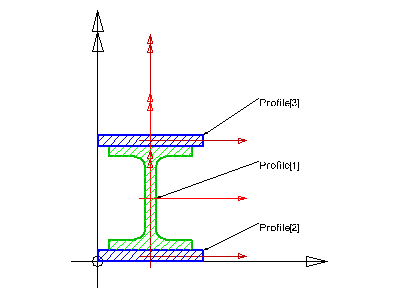Natural language names
 | Zusammengesetztes Profil |
 | Composite Profile Def |
 | Définition de profil composite |
 | Zusammengesetztes Profil |
 | Composite Profile Def |
 | Définition de profil composite |
The IfcCompositeProfileDef defines the profile by composition of other profiles. The composition is given by a set of at least two other profile definitions. Any profile definition (except for another composite profile) can be used to construct the composite.
HISTORY New entity in IFC2x.
Figure 314 illustrates the composite profile definition. The IfcCompositeProfileDef does not define an own position coordinate system, it is directly defined in the underlying coordinate system. The underlying coordinate system is defined by the swept surface or swept area solid that uses the profile definition. It is the xy plane of either:
Or in case of sectioned spines it is the xy plane of each list member of IfcSectionedSpine.CrossSectionPositions. The IfcCompositeProfileDef is defined using other profile definitions. Those other profile definitions are directly inserted into the underlying coordinate system.
NOTE The black coordinate axes show the underlying coordinate system of the swept surface or swept area solid.
 |
Figure 314 |
Twin profiles special case
If twin profiles are modeled by profile composition, the base profile should only be specified once. It is then included into the composite profile directly and additionally indirectly via IfcMirroredProfileDef. For example, a double angle made of two L100x10 with 10mm air gap between them, i.e. a _| |_ shape, can be modeled as
single_L : IfcLShapeProfileDef := IfcLShapeProfileDef(AREA, 'L100X100X10',
IfcAxis2Placement2D(IfcCartesianPoint(((.100+.010)/2., .0)), ?),
.100, .100, .010, .012, ?, 0., ?, ?);
double_L : IfcCompositeProfileDef := IfcCompositeProfileDef(AREA, 'double angle',
(single_L, IfcMirroredProfileDef(AREA, ?, single_L, ?)), 'twin profile');
| # | Attribute | Type | Cardinality | Description | C |
|---|---|---|---|---|---|
| 3 | Profiles | IfcProfileDef | S[2:?] | The profiles which are used to define the composite profile. | X |
| 4 | Label | IfcLabel | [0:1] | The name by which the composition may be referred to. The actual meaning of the name has to be defined in the context of applications. | X |
| Rule | Description |
|---|---|
| InvariantProfileType | Either all profiles are areas or all profiles are curves. |
| NoRecursion | A composite profile should not include another composite profile, i.e. no recursive definitions should be allowed. |

| # | Attribute | Type | Cardinality | Description | C |
|---|---|---|---|---|---|
| IfcProfileDef | |||||
| 1 | ProfileType | IfcProfileTypeEnum | [1:1] | Defines the type of geometry into which this profile definition shall be resolved, either a curve or a surface area. In case of curve the profile should be referenced by a swept surface, in case of area the profile should be referenced by a swept area solid. | X |
| 2 | ProfileName | IfcLabel | [0:1] | Human-readable name of the profile, for example according to a standard profile table. As noted above, machine-readable standardized profile designations should be provided in IfcExternalReference.ItemReference. | X |
| HasExternalReference | IfcExternalReferenceRelationship @RelatedResourceObjects | S[0:?] | Reference to external information, e.g. library, classification, or document information, which is associated with the profile. | X | |
| HasProperties | IfcProfileProperties @ProfileDefinition | S[0:?] | Additional properties of the profile, for example mechanical properties. | X | |
| IfcCompositeProfileDef | |||||
| 3 | Profiles | IfcProfileDef | S[2:?] | The profiles which are used to define the composite profile. | X |
| 4 | Label | IfcLabel | [0:1] | The name by which the composition may be referred to. The actual meaning of the name has to be defined in the context of applications. | X |
| # | Concept | Model View |
|---|---|---|
| IfcProfileDef | ||
| Property Sets for Objects | Common Use Definitions | |
<xs:element name="IfcCompositeProfileDef" type="ifc:IfcCompositeProfileDef" substitutionGroup="ifc:IfcProfileDef" nillable="true"/>
<xs:complexType name="IfcCompositeProfileDef">
<xs:complexContent>
<xs:extension base="ifc:IfcProfileDef">
<xs:sequence>
<xs:element name="Profiles">
<xs:complexType>
<xs:sequence>
<xs:element ref="ifc:IfcProfileDef" minOccurs="2" maxOccurs="unbounded"/>
</xs:sequence>
<xs:attribute ref="ifc:itemType" fixed="ifc:IfcProfileDef"/>
<xs:attribute ref="ifc:cType" fixed="set"/>
<xs:attribute ref="ifc:arraySize" use="optional"/>
</xs:complexType>
</xs:element>
</xs:sequence>
<xs:attribute name="Label" type="ifc:IfcLabel" use="optional"/>
</xs:extension>
</xs:complexContent>
</xs:complexType>
ENTITY IfcCompositeProfileDef
SUBTYPE OF (IfcProfileDef);
Profiles : SET [2:?] OF IfcProfileDef;
Label : OPTIONAL IfcLabel;
WHERE
InvariantProfileType : SIZEOF(QUERY(temp <* Profiles | temp.ProfileType <> Profiles[1].ProfileType)) = 0;
NoRecursion : SIZEOF(QUERY(temp <* Profiles | 'IFCPROFILERESOURCE.IFCCOMPOSITEPROFILEDEF' IN TYPEOF(temp))) = 0;
END_ENTITY;